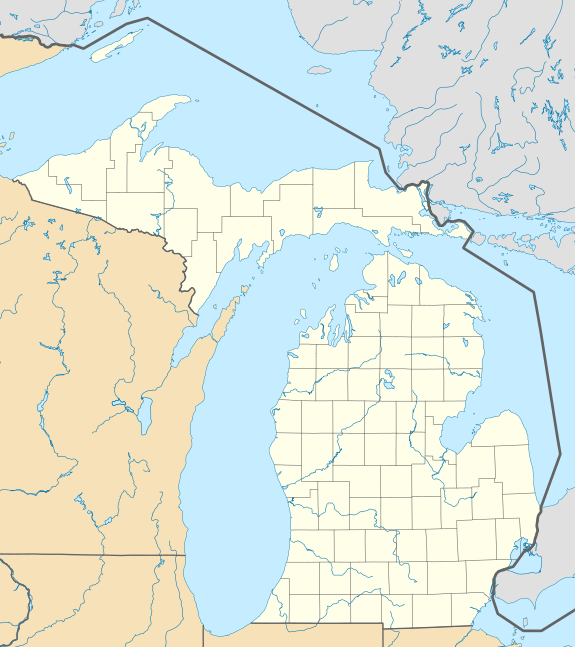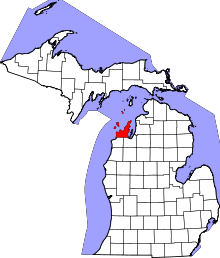Leland, Michigan
| Leland, Michigan | |
|---|---|
| unincorporated community | |
|
Aerial view of the shore and harbor at Leland, Michigan | |
 Leland, Michigan Location within the state of Michigan | |
| Coordinates: 45°1′27.7″N 85°45′44.75″W / 45.024361°N 85.7624306°WCoordinates: 45°1′27.7″N 85°45′44.75″W / 45.024361°N 85.7624306°W | |
| Country | United States |
| State | Michigan |
| County | Leelanau County |
| Settled | 1853 |
| Elevation | 581 ft (177 m) |
| Population (2000) | |
| • Total | 2,033 (Leland Township) |
| ZIP Code | 49654 |
| Area code(s) | 231 |
| FIPS code | 26089 |
| Website | http://www.lelandmi.com/ |
Leland is an unincorporated community in the U.S. state of Michigan. It was the county seat of Leelanau County[1] from 1883 to 2008, when a new government center was completed in Suttons Bay Township, closer to the county's geographic center.
Leland is located in Leland Township, which provides local government services. It is on M-22 at the mouth of the Leland River (also known as the Carp River) on Lake Michigan.
Leland is the departure point for ferry service to both North and South Manitou Islands. The Sleeping Bear Dunes National Lakeshore is nearby and Traverse City is about 25 miles to the southeast.
History
Leland is built on the site of one of the oldest and largest Ottawa villages on the Leelanau Peninsula. Where the Leland (Carp) River flows into Lake Michigan, there was a natural fish ladder which was a traditional Native American fishing grounds. The settlement was called Mishi-me-go-bing, meaning "the place where canoes run up into the river to land, because they have no harbor" or alternatively Che-ma-go-bing or Chi-mak-a-ping.
White settlers, who began arriving in the 1830s, also took advantage of the location as a fishing settlement. White settlement increased after Antoine Manseau, with his son Antoine Jr., and John Miller, built a dam and sawmill on the river in 1854. Construction of the dam raised the water level 12 feet and what had been three natural lakes in the river all became a single lake now known as Lake Leelanau (and is navigable all the way to the community of Cedar, about 10 miles inland). The settlers built wooden docks, which allowed steamers and schooners to transport new settlers and supplies.
From 1870 to 1884 the Leland Lake Superior Iron Co. operated an iron smelter north of the river mouth, supplied with ore from the Upper Peninsula and charcoal made from local maple and beech timber; the charcoal was produced in fourteen beehive kilns near the smelting furnace, which produced up to 40 tons of iron per day. In 1884 the plant was sold to the Leland Lumber Co. which operated a saw mill on the site. Other sawmills and shingle mills operated in Leland during the years 1885-1900.[2]
As early as 1880, commercial fishermen sailed out of the harbor to catch trout and whitefish, building wooden shacks where they processed their catch and serviced their fleet. Up to eight powered tugs once sailed out of "Fishtown," as the buildings came to be known. Today, the historic fishing settlement and two fish tugs, Joy and Janice Sue, are owned by a non-profit organization, Fishtown Preservation Society.[3] Fishtown is home to a working fishery and a thriving charter fishing business. The riverfront is lined by a boardwalk and quaint shacks that have been converted into tourist shops.
Around 1900, wealthy individuals from Chicago, Cincinnati, Indianapolis and other Midwestern industrial centers began to visit Leland and build summer cottages, arriving by Lake Michigan passenger steamer or by Lake Leelanau steamer from the railhead near Traverse City. This led to the construction of resort hotels, and the growth of Leland as a summer resort.
Transportation
Cultural Institutions
Leland is home to the Leelanau Historical Society and Museum, two blocks from Fishtown.
Notable people
- Tim Allen (born 1953), comedian, actor
- Thomas W. L. Ashley (1923-2010), U.S. representative (Ohio)
- The Ball Brothers, industrialists and philanthropists
- Charles E. Bennison (born 1943), Episcopal bishop of Pennsylvania
- Walter Truman Best, aka Edward Maro (1869-1908), musician, magician[4][5]
- John Elder Blackledge (1891-1961), magician[6]
- Barbara Ninde Byfield (1930-1988), author, illustrator
- Mark Clark (1896-1984), WW2 general, Citadel president
- Karl Detzer (1891-1987), author, biographer of Carl Sandburg
- John J. Gilligan (1921-2013), U.S. representative, governor of Ohio
- Alisha Glass (born 1988), Olympic volleyball player [7]
- Jim Harrison (1937-2016), author, township resident from 1968-2002
- Harlan Hatcher (1898-1998), University of Michigan president
- Arthur F. Lederle (1887–1972), U.S. federal judge
- Linda Lindquist-Bishop (born 1962), offshore yacht racer[8]
- Alvin Mansfield Owsley (1888-1967), attorney, diplomat
- Keewaydinoquay Peschel (ca. 1919-1999), ethnobotanist, herbalist, educator
- Emelia Schaub (1891-1995), county prosecutor, first female attorney in Michigan
- Kathleen Sebelius (born 1948), U.S. Secretary of Health and Human Services, governor of Kansas, daughter of John J. Gilligan
- Tobin Sprout (born 1955), songwriter, guitarist (Guided by Voices)
Images
 Sign on M-22
Sign on M-22 Downtown Leland on M-22
Downtown Leland on M-22
References
- ↑ "Find a County". National Association of Counties. Retrieved 2011-06-07.
- ↑ Littell, E.M., 100 Years in Leelanau, pp. 38-40.
- ↑ Fishtown Preservation Society home page.
- ↑ Leelanau Illusionist: Maro the Magician, Leelanau Enterprise, 10 May 2012
- ↑ Edward Maro at Magicpedia
- ↑ John Blackledge at Magicpedia
- ↑ Alisha Glass at USA Volleyball
- ↑
Further reading
- Clarke Historical Library, Central, Michigan University, Bibliography for Leelanau County
- Bogue, Margaret. Around the Shores of Lake Michigan: A Guide to Historic Sites. Madison, WI: University of Wisconsin Press, 1985.
- Byron, M. Christine, and Thomas R. Wilson. Vintage Views of Leelanau County. Chelsea, MI: Sleeping Bear Press, 2002.
- Dickinson, Frederick W. A Short History of the Leland Iron Works. Annotated by Harley W. Rhodehamel. Leland, MI: Leelanau Historical Society, 1996.
- Littell, Edmund M. 100 Years in Leelanau. Leland: The Print Shop, 1965.
- Littell, Joseph. Leland: An Historical Sketch. [Indianapolis, IN: Indianapolis Printing Co., 1920], reprinted 1959.
- Mitchell, John C. Wood Boats of Leelanau: A Photographic Journal. Leland, MI: Leelanau Historical Society, 2007.
- Reed, Earl H. The Dune Country. Berrien Springs, MI: Hardscrabble Books, 1979. [Reprint of 1916 Edition].
- Ruchhoft, Robert H. Exploring North Manitou, South Manitou, High and Garden Islands of the Lake Michigan Archipelago. Cincinnati, OH: Pucelle Press, 1991.
- Sommers, Laurie Kay. Fishtown: Leland, Michigan's Historic Fishery. Traverse City, MI: Arbutus Press, 2012.
- Wood, Mable C. Scooterville, U.S.A. Grand Rapids, MI: Eerdmans, 1962.

